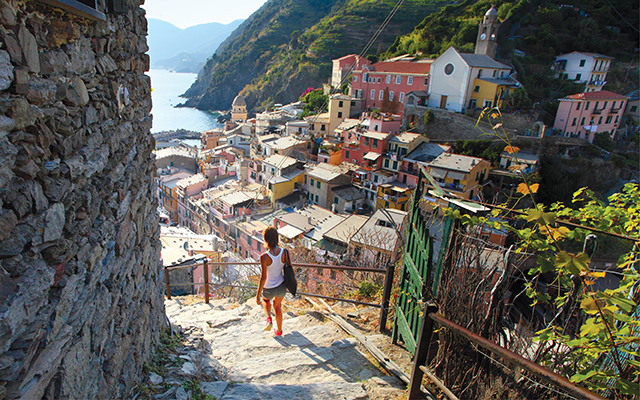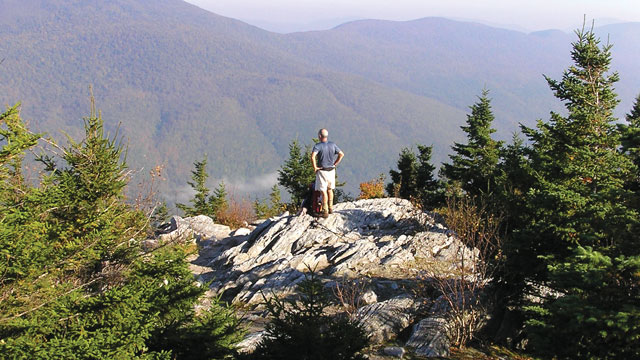Like pearls on a necklace, the five coastal Italian villages known as the Cinque Terre are connected by a scenic, eight-mile walking trail. Years ago, my husband and I spent two days walking from town to town on this seaside route, and it captured our hearts. Never mind that every B&B was full and we shuttled between picturesque “old” Italy and a train-station hotel in a distant city each night. Never mind that our quads quivered while climbing the 382 steps to reach a cliff-top village, or that my husband stepped on a sea urchin while swimming in the azure Ligurian Sea.
What we remember is walking into Vernazza and being greeted by pastel houses glowing in the sunlight and laundry dangling from balconies. We flopped on the rocky beach and watched fishermen unload their catch; we savored pasta drenched in fresh pesto. After weeks of sightseeing via the autostrada, we discovered the true meaning of il dolce far niente: “the sweetness of doing nothing.”
Long before boats, trains, cars, and planes, humans traveled from place to place using bipedal locomotion. Whether they were moving cows to greener pastures or making a pilgrimage to a sacred site, the journey was as meaningful as the destination.
For the contemporary traveler, walking allows enough time to take in subtler elements of a place, like the sound of local birds or the food smells wafting from homes and restaurants. Trips by foot often veer off the beaten path, revealing unexpected treasures one might never discover otherwise.
Walking trips don’t typically require the rigorous training necessary for serious wilderness hikes. Growing numbers of outfitters offer multiday village-to-village walking itineraries. They book accommodations, supply detailed directions, and transport luggage from place to place. Foot travelers need carry only a map, water, snacks, foul-weather gear, and a first-aid kit. There are also full-service group walking tours that provide expert guides and stand-by vehicles for sick or tired hikers.
Here are three trips that will inspire you to lace up your walking shoes and step out.
Vermont Inn-to-Inn Circuit
Type: Four days of self-guided, inn-to-inn walking
Walk rating: Easy to moderate (10 to 11 miles daily)
Vermont Inn to Inn Walking Tours: $600 to $700/person (includes lodging, breakfasts, dinners, and trail snacks); www.vermontinntoinnwalking.com.
Over four September days, Stephanie and Richard Paulhus celebrated their 25th wedding anniversary walking along southern Vermont’s back roads. The Northfield, N.H., couple spent six or seven hours a day strolling past stone fences, lakes, wooden churches, and country stores.
“The trip was like a treasure hunt,” says Richard, 49, a police officer. Each morning an innkeeper from Vermont Inn to Inn Walking Tours took them to a drop-off spot, handing them instructions for a 10-mile scenic route ending at that night’s inn. “The directions said things like ‘Turn left at the red barn with the roosters out front,’” Richard recalls.
When the Paulhuses arrived at their next B&B each afternoon, their luggage was waiting. They relaxed on the porch while dinner cooked. “The walking trip took us out of our element,” says Stephanie, 49, a nurse. “Richard had never stayed at a B&B before, but we felt right at home.”
The innkeepers excelled at helping their guests. One rainy day, one of the hosts drove out to see if the Paulhuses wanted a ride. When they declined — “because we were there to walk!” exclaims Richard — the innkeeper gave them his cell number in case they changed their minds. When the soggy couple arrived at the inn, a roaring fire and hot chocolate were waiting.
Though the Paulhuses insisted on walking, rain or shine, they never rushed. “It was vacation, not a race,” says Richard. “In four solid days together, we never got tired of talking.”
Morocco on Foot
Type: Guided group tour from Fés to Marrakesh: 11 days/10 nights
Walk rating: Easy to moderate (3 to 6 miles daily)
Country Walkers: $5,300/person (includes guides, transportation, lodging, and meals); www.cwadventure.com.
In the shifting sands of a Moroccan dune, Susan Schweitzer, 68, slid half a step backward for each step she took, but at the summit, she and her fellow adventurers watched a brilliant red sun set behind a sea of sand. Afterward, the group hiked down the dune and rode camels back to the Tuareg tent camp.
The desert was just one of the Moroccan landscapes that Schweitzer experienced during her guided Country Walkers (CW) tour, which centered around foot travel but included van transportation to reach more remote parts of the country. One day the group would stroll the medieval city streets of Marrakesh; the next, they hiked to waterfalls in the Atlas Mountains; on another, they walked from one Berber village to the next.
“Having the chance to walk in places throughout the country gave me a feel for how people live in many parts of Morocco,” says Schweitzer, a retired social worker from Haverford, Pa. The walking tour offered an on-the-ground sense of place. “[It was] more intimate than whizzing by on a bus or bike.”
Guide Saida Ezzahoui, a native of Fès, helped Schweitzer bargain in the souks (marketplaces) and served as translator and cultural ambassador.
“I introduce the Berbers, who have big hospitality,” says Ezzahoui, who has escorted CW tours in Morocco since 1999. “Whenever we pass a Berber home or a farmer working in his field, they invite us to share a glass of mint tea.” (Schweitzer’s group lunched with a family in their home.)
Schweitzer also found herself astonished by Morocco’s artisanal traditions. In the marketplace, she watched artists dying leather and sewing it into slippers and handbags, and observed others embroidering flowing djellaba robes. “Morocco is filled with the sights and smells of an old-world culture that’s disappearing,” she says. “I’m glad I got to experience it one step at a time.”
England’s Cotswold Way Adventure
Type: 102-mile trail. Six days/seven nights of self-guided village-to-village walking
Walk rating: Moderate to challenging (12 to 20 miles daily)
Cotswold Walks: About $640/person (includes lodging and breakfasts); www.cotswoldwalks.com.
The Cotswold Hill region, dubbed the Walking Capital of England, is famous for its quaint villages and grazing sheep. The 102-mile Cotswold Way National Trail, which leads from Chipping Campden to the city of Bath, attracts many avid through-walkers, including Dave Horton, 53, and his two teenage girls.
“I wanted an active trip and quality time with my daughters,” says Horton, a software engineer from Mansfield, Mass. He booked the family on a self-guided, six-day Cotswold Way trek, the fastest and most difficult route — averaging 17 miles per day. “We loved the challenge of a set daily distance and the reward of sleeping in a comfy B&B,” Horton says.
Each night, the girls pored over the map, anticipating the adventure ahead. The family hit the trail by 8:30 a.m. and tramped past villages, castles, and farms, often taking a lunch break at a local pub. (In England, pubs are family-friendly.) They reached their destination town by 5 or 6 p.m.
“Self-guided tours let you control the pace and where you wish to linger,” says Andrew Guppy, owner of Cotswold Walks. He notes the advantages of hiring a local company to handle trip logistics: They know the region’s footpaths and can suggest good routes and the best itinerary to suit your needs. They also book your accommodations in advance after inspecting them first. (Many walkers mistakenly assume they can stroll into a touristy village and find lodging on the spot.)
Finally, local companies give good advice. “I try to convince clients to allow time to enjoy the Cotswolds without rushing,” Guppy says.
There were some low points for the Hortons, like the day they hiked 16 miles into a driving rain. But even those trials had their redeeming moments. “We were shivering in full rain gear — fleece, rain pants, raincoats — when we saw an English gent jogging in shorts and a T-shirt,” Horton recalls. “The girls and I stared at each other in disbelief and just laughed.”
When the family arrived at Bath Abbey, the trail’s end, they were “tired but happy,” Horton says. “And we felt we’d accomplished something huge.”
Fit for the Footpath
Walking trips require a fair amount of endurance, balance, joint mobility, and stability. “If you’ve already been working out, you might only need to refine your training to prepare for a consecutive-day walking tour,” says trainer Marcus Shapiro, founder of Fit for Trips, a company that creates itinerary-specific workouts for outdoor adventurers.
A month of physical training is plenty for an easy trip, Shapiro says. Two to three months is optimal if the trip is strenuous — or if you’re trying to get in shape. “People need a goal to get moving and grooving,” he says. “An upcoming walking tour is great motivation.”
According to Shapiro, you can probably handle a walking trip if you:
- Can walk about 10,000 steps (four to five miles) daily
- Are comfortable walking up and down moderate hills or steps
- Can cover 10 kilometers (6.2 miles) of flat, level trail in about 2.5 hours.
- Prepare with a weekly hike (three to four hours) carrying a pack that’s heavier than the one you’ll carry on the trip.




This Post Has 0 Comments